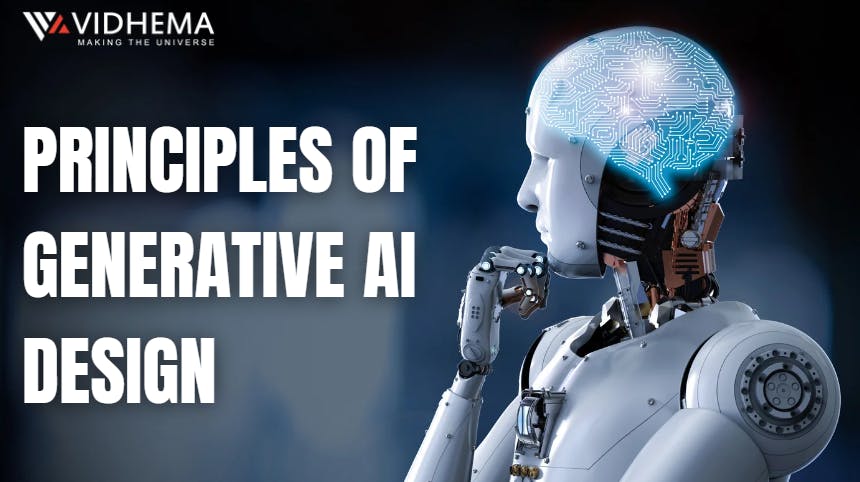Principles of Generative AI Design

In an era when technology is constantly redefining the limits of human creativity, Generative Artificial Intelligence (AI) has emerged as a disruptive force in a variety of areas. AI systems are increasingly being used to supplement human creativity and develop innovative, inspiring works in fields ranging from art and music to content generation and design. However, realizing the full potential of Generative AI necessitates a thorough understanding of its concepts as well as a careful approach to design. We’ll look at the core ideas of Generative AI Design and how they’re transforming the creative landscape in this post.
Principle 1: Data-Driven Creativity
Data, and lots of it, is at the heart of Generative AI. The Data-Driven Creativity principle recognizes that AI systems learn from massive datasets to develop material that mimics real-world patterns and styles. The quality and diversity of the training data determine the quality and relevance of the output, whether it is text, images, or music. As a result, curating, cleansing, and organizing data have become critical jobs in Generative AI design.
Principle 2: The Power of Neural Networks
Neural networks, notably Generative Adversarial Networks (GANs) and Recurrent Neural Networks (RNNs), are heavily used in generative AI. By putting two neural networks against each other — the generator and the discriminator — GANs enable AI systems to produce content. This adversarial process produces content that is becoming increasingly difficult to discern from human-created information. RNNs, on the other hand, are required for sequential data generation, which makes them crucial in jobs such as text and music generation.
Principle 3: The Role of Feedback Loops
Feedback loops are critical for refining and improving the output of Generative AI empowering. These loops enable designers and engineers to improve the AI’s performance iteratively. Designers can lead the AI towards more desirable outputs by analyzing the generated information, discovering mistakes or inconsistencies, and providing input to the system. Continuous learning and feedback-based adaptation are critical ideas for improving results.
Principle 4: Creative Constraints and Guidelines
While AI can generate a wide range of content, creative limits and rules must be established. These criteria aid in the definition of the AI’s creative boundaries and the alignment of its output with human purpose. In graphic design, for example, providing color palettes, typographic rules, or composition principles can aid in maintaining the desired visual style. Establishing these restrictions guarantees that AI-generated material complements rather than replaces human innovation.
Principle 5: Ethical Considerations
It is not only about technology in generative AI design; it is also about ethics. The Ethical Considerations principle emphasizes designers’ and developers’ responsibilities to ensure that AI-generated content adheres to ethical norms and social values. Addressing challenges like as bias in training data, preventing damaging or objectionable content development, and being open about the AI’s role in the creative process are all part of this.
Principle 6: Collaboration Between Humans and AI
When collaborating with human creators, generative AI is most productive. This approach recognizes AI as a tool to augment rather than replace human ingenuity. AI can be used by designers, authors, and artists as a source of inspiration, a creative helper, or to automate monotonous activities. The combination of human intuition and AI skills frequently produces astonishing results.
Principle 7: Interpretable AI
The necessity for interpretable AI becomes crucial as AI systems get more advanced. This principle promotes openness in AI decision-making processes. Understanding how and why AI generates specific content allows designers and consumers to have confidence in and control over the AI. Designers may use interpretable AI to fine-tune AI outputs, remedy errors, and confidently make creative decisions.
Principle 8: Continuous Learning and Adaptation
Generative AI is not a static entity; it changes over time and with experience. This idea emphasizes the significance of ongoing learning and adaptation. AI systems should be built to respond to changing trends, user feedback, and developing creative needs. AI is constantly updated and improved, ensuring that it stays a powerful creative tool.
Principle 9: User-Centric Design
Finally, Generative AI should cater to its users’ wants and preferences. The need to create AI systems with the user experience in mind is emphasized by User-Centric Design. AI-generated content should be relevant, interesting, and relevant to the user’s objectives. A user-centric strategy ensures that AI-generated content is appealing to the intended audience.
Principle 10: Innovation and Exploration
Finally, Generative AI Design fosters creativity and inquiry. AI offers an intriguing frontier for experimentation, and creativity has no limitations. Designers and developers are urged to push the creative boundaries of what AI can achieve. Embracing the spirit of discovery and curiosity drives the ongoing advancement of AI-generated content.
Finally, the Generative AI Design principles give a framework for traversing the creative border where artificial intelligence and human creativity interact. Designers and developers may leverage the full potential of AI to increase their creative powers by understanding and utilizing these ideas. Generative AI is more than simply a tool; it is a collaborator in the creative process, opening up new channels for creativity and expression. As technology advances, the AI future of creativity is only limited by our imagination and our ability to properly apply these concepts.
